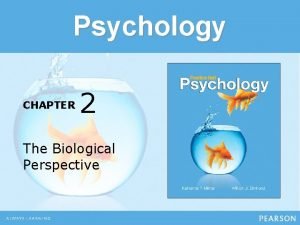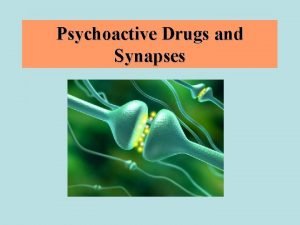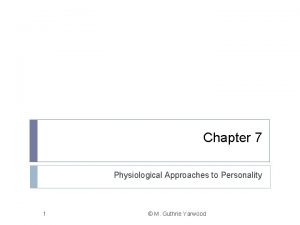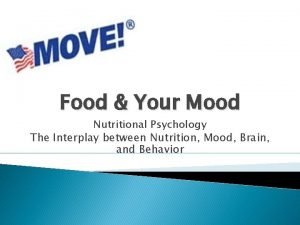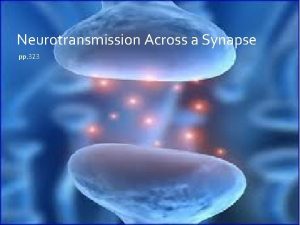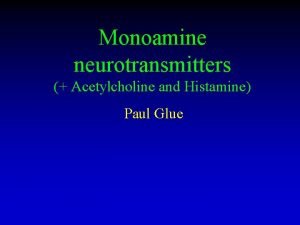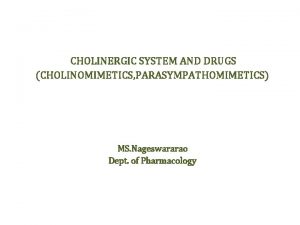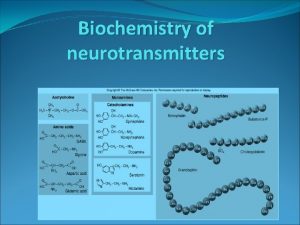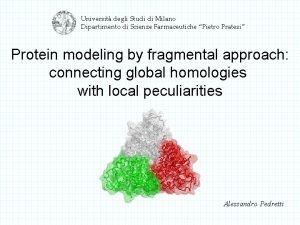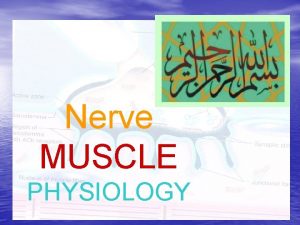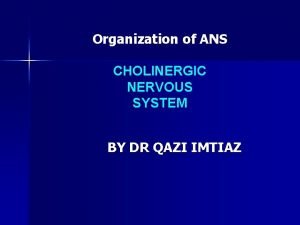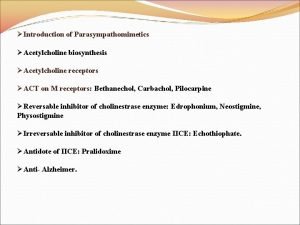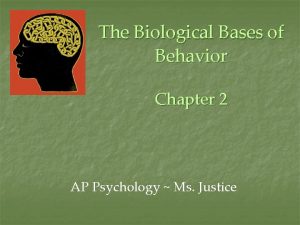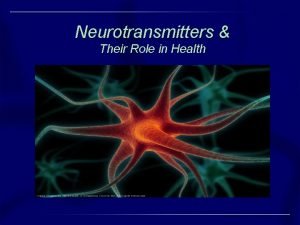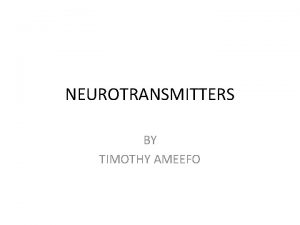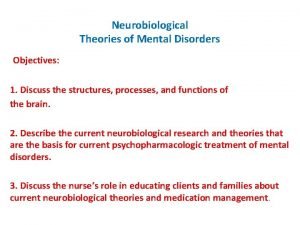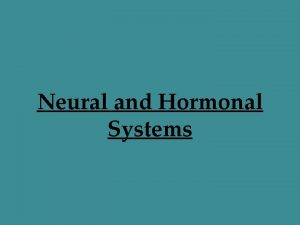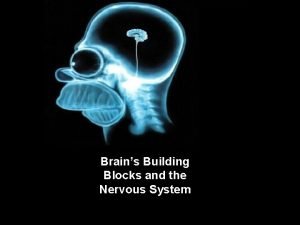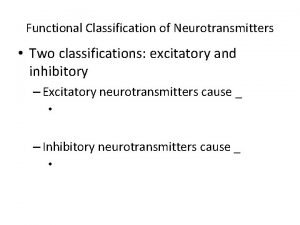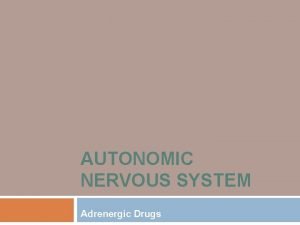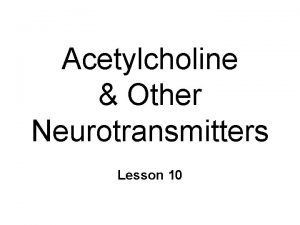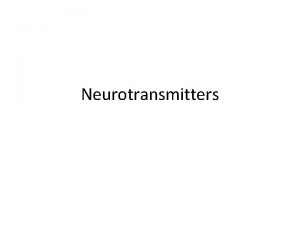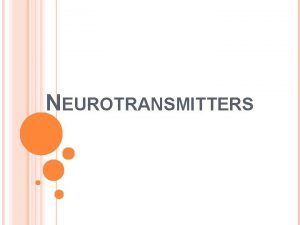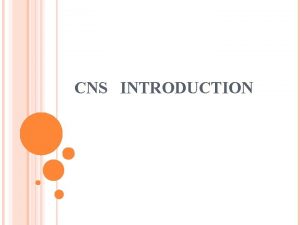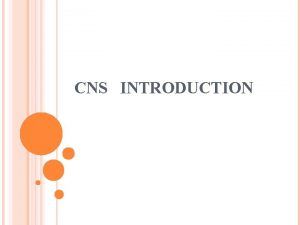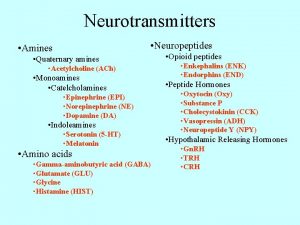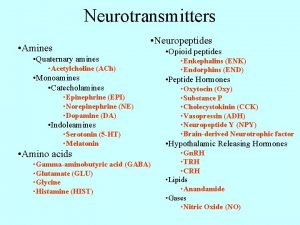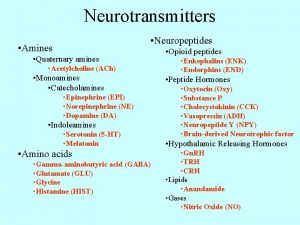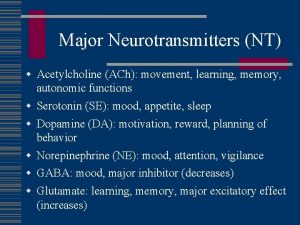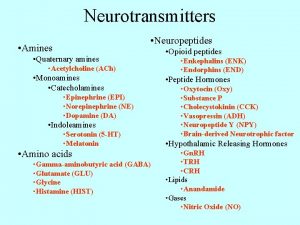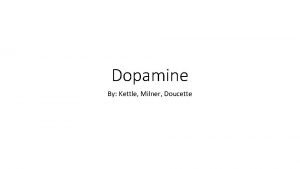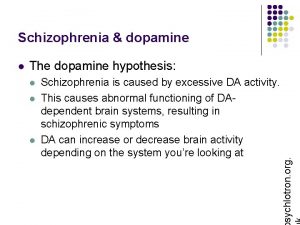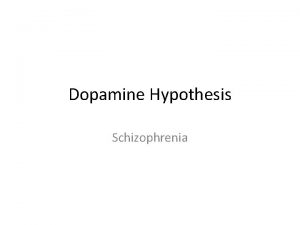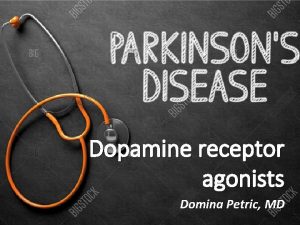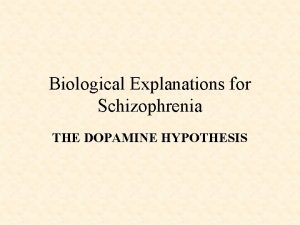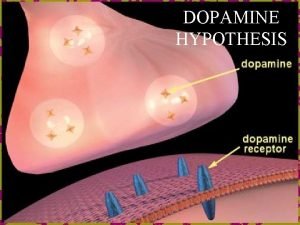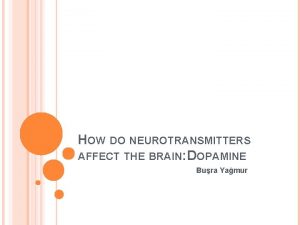Neurotransmitters Acetylcholine and Dopamine Ms Carmelitano Acetylcholine First






















- Slides: 22

Neurotransmitters: Acetylcholine and Dopamine Ms. Carmelitano

Acetylcholine • First Neurotransmitter to be identified and most common in the human body • Function: – Helps control muscle contraction – Plays a role in the development of memory of the hippocampus • Hippocampus: Part of the brain responsible for converting short-term memory into long-term memory

Acetylcholine • Acetylcholine and memory formation – It is still not fully understood how memory formation occurs – However, research has shown that when a shortterm memory is converted into long-term storage in the hippocampus, neurons in the brain help to synthesize protein molecules and new connections between neurons are formed

Acetylcholine • So, what does this have to do with psychology you ask? ? – Over or underproduction cause us to act in certain ways!

Malfunction of Acetylcholine • Underproduction on Memory – Because acetylcholine plays a huge role in memory, an underproduction cause memory loss or inhibit the formation of new memories – It has been discovered that people who suffer Alzheimer's have a deterioration in the dendrites in neurons that play a role in memory, and therefore a deterioration in the amount of acetylcholine

Martinez and Kesner (1991) • Aim: To investigate the role of Acetylcholine on memory • Procedure: Can – 1. Rats were trained to go through a maze and get to the end, where they received food. you solve the maze?

Martinez and Kesner (1991) • Procedure: – 2. Once the rats were able to do this, the researchers injected one group of rats with scopolamine, which blocks acetylcholine receptor sites decreasing available acetylcholine. – 3. Then the second group of rats was injected with physostigmine, which blocks the production of cholinesterase which does the “clean-up” of acetylcholine from the synapse and returns the neuron to its “resting state” – 4. The third group, control group, were not given any injections.

Second Place WINNER!

Martinez and Kesner (1991) • Findings: – The rats that were injected with scopolamine were slower at finding their way round the maze and made the most errors – The physostigmine group ran through the maze and found the food more quickly and took fewer wrong turns. – The researchers concluded that acetylcholine played an important role in creating a memory of the maze.

Nicotine and Acetylcholine • When a person smokes a cigarette, they will put nicotine into their system • Nicotine will stimulate neurons to release more acetylcholine • The overproduction of Acetylcholine will give a person an “energized” feeling, muscles react faster and the brain functions faster • Smokers become addicted, and need a cigarette in the morning to “wake-up”

Dopamine • Function: – voluntary muscle movement – Learning – Feelings of emotion: pleasure

Dopamine • Dopamine and voluntary muscle movement – When the body reacts to a stimuli that calls for muscle movement (example: I hear a noise and turn my head to see what it was) Dopamine will be released over the synapses of nerve cells. – The Dopamine will bind with receptors that cause a chemical reaction to move smooth muscles in the basil ganglia – the portion of the brain that coordinates smooth muscle movement

Dopamine • Dopamine and learning and emotion – Dopamine controls the transfer of messages in the frontal cortex of the brain which controls memory, attention, and problem solving ability – When dopamine is released, it creates a “feelgood” feeling within the individual • The individual learns what behaviors will create this feel good feeling • They will learn that if they continue this behavior, the feeling will continue

Malfunction of Dopamine • Malfunction of Dopamine and muscle movement – When dopamine receptors are blocked, or not enough dopamine is produced, a person will find muscle coordination difficult – People who do not produce enough dopamine develop Parkinson • Parkinson is degenerative – this means that it progressively gets worse. A person with Parkinson's Disease will gradually produce less and less dopamine over time

Malfunction of Dopamine • Malfunction of Dopamine in learning and emotion – Because Dopamine regulates connections between neurons responsible for concentration in the frontal lobe, a person without enough dopamine may develop ADD – Low dopamine may also cause dementia because the neurotransmitter helps make connection with learning and memory. This usually occurs with age as the neurons that produce dopamine begin to degrade – Low dopamine may also be a reason for depression, low dopamine will decrease the pleasure feeling

Malfunction of Dopamine and Schizophrenia • Schizophrenia is a mental illness – People suffering from Schizophrenia report feeling paranoid, having hallucinations, and even hearing voices that are not there • An overproduction of Dopamine in one area of the brain has been linked to Schizophrenia. This overproduction of Dopamine can cause the hallucinations linked to Schizophrenia

Drugs and Dopamine • Drugs prescribed to help people with ADD concentrate increase the amount of dopamine that is released in the brain • People with Schizophrenia will be given drugs to inhibit dopamine production, however, as a side effect, this makes it hard for the person to concentrate, reduce feelings of pleasure, and reduce motor function

Drugs and Dopamine • Most drugs, such as alcohol, cocaine, and amphetamines increase the production of dopamine in the brain – This is why people get addicted to drugs – They feel good when they take them – They become used to the over production of dopamine in their brain, and find it hard to concentrate or feel pleasure without the drug as they become dependent on it

Cardinal et al (2001) • Procedure: – Researchers gave a set of rats choices between bowls of food containing large and small portions – Rats chose the larger consistently – The researchers split the rats into two groups • Lesioned their nucleus accumbens (Where Dopamine and Serotonin is produced) This caused excess Dopamine to be produced • One group received an anti-psychotic on did not – When presented a choice between large and small portions of food, the rats were more impulsive and simply chose the bowl closer to them. They appeared hyper-active

• Findings: – Excess Dopamine in the brain lead the rats to be more impulsive – This could be why drug addicts are impulsive

Laurelle et al (1996) • Procedure: – Researchers gathered participants who were and were not diagnosed with Schizophrenia – Researchers gave participants an amphetamine, a drug, that increased levels of dopamine in the brain – Researchers observed patients and interviewed them about how they were feeling

• Findings: – Observations and interviews confirmed that the “healthy” patients began to experience symptoms of Schizophrenia when their Dopamine levels were forced to rise – Patients tested who were diagnosed with Schizophrenia had their symptoms worsen
 Neurotransmitters and their functions
Neurotransmitters and their functions Neurotransmitters and drugs
Neurotransmitters and drugs Neurotransmitters and personality
Neurotransmitters and personality Dopamine and serotonin pathways
Dopamine and serotonin pathways Português
Português Monoamine acetylcholine
Monoamine acetylcholine M cholinomimetic drugs examples
M cholinomimetic drugs examples Where are neurotransmitters produced
Where are neurotransmitters produced Myasthenic crisis vs cholinergic crisis
Myasthenic crisis vs cholinergic crisis Nicotine acetylcholine receptors
Nicotine acetylcholine receptors Nicotine acetylcholine receptors
Nicotine acetylcholine receptors T tubule
T tubule Parasympathetic and cholinergic
Parasympathetic and cholinergic Acetylcholine biosynthesis
Acetylcholine biosynthesis Role of neurotransmitters
Role of neurotransmitters How do neurotransmitters influence behavior
How do neurotransmitters influence behavior Inhibitory neurotransmitters
Inhibitory neurotransmitters List of neurotransmitters
List of neurotransmitters Norepinephrine role
Norepinephrine role Reuptake of neurotransmitters
Reuptake of neurotransmitters How do neurotransmitters influence behavior
How do neurotransmitters influence behavior Functional classification of neurotransmitters
Functional classification of neurotransmitters Sns neurotransmitters
Sns neurotransmitters
